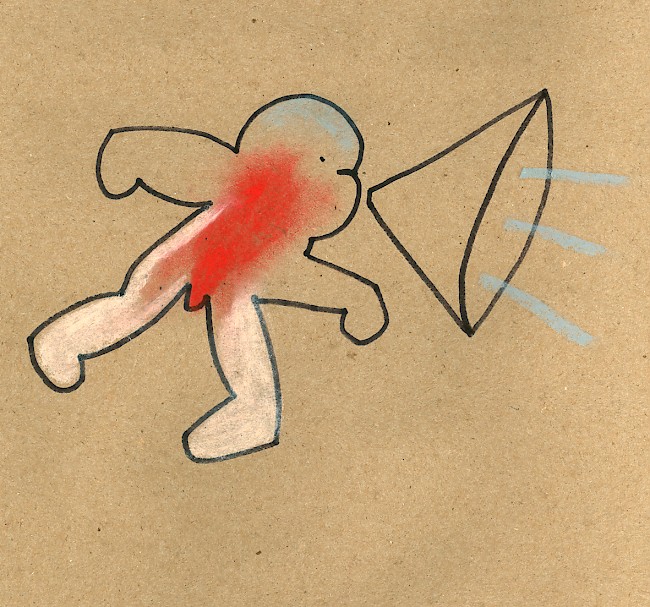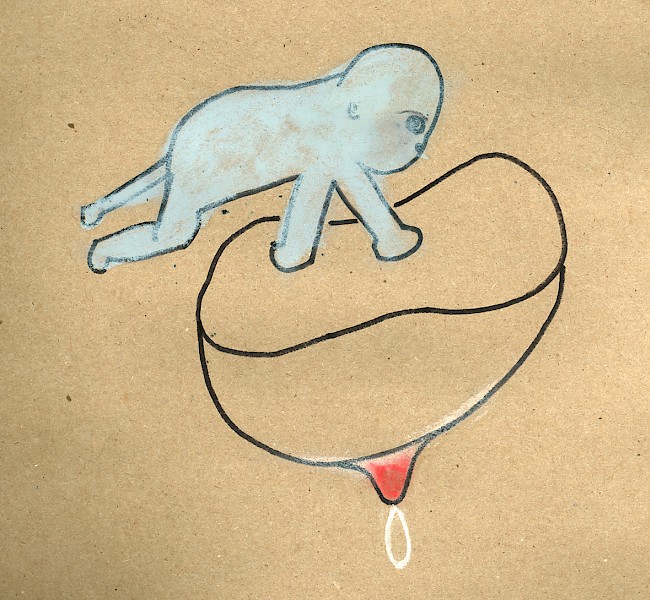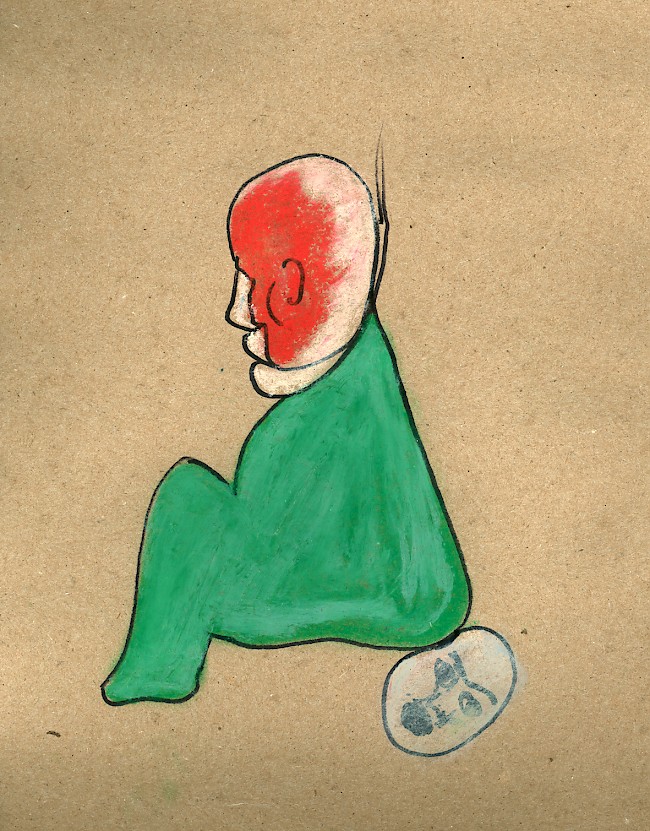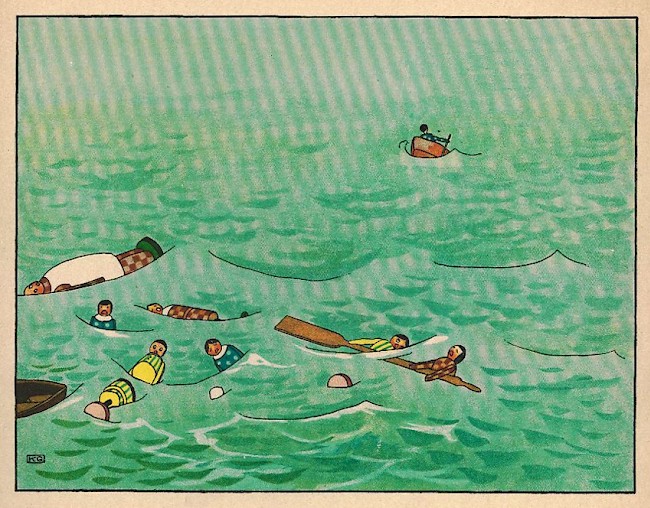— Child as Material

Those who never saw La Borde’s shit pit in person, under that open sky, cannot possibly fathom the extraordinary range of colors, shapes, and textures of that human creation. Our fascination, as children, with that giant pool, that huge sea of shit, made us defy all rules. Located at a distance, past the buildings of the sawmill, two basins, staring into the sky, held that astounding content. We climbed onto the narrow stone blocks that surrounded it and walked along carefully, following each other, babbling away and entertaining debates above that wild pile. We did this for quite a long time. Until one of us fell in. Then, shit pit times were over; aside from the strict orders we’d been given to stay away, they started a landfill project on it.
— Emmanuelle Guattari.1 Emmanuelle Guattari, I, Little Asylum (Los Angeles: Semiotext(e), 2014), 28.
It’s curious how a specific seam of children’s literature from the 1970s shows a consciously pedagogical impetus on the part of the author in forming the child protagonist of a book, to make sure the reader realizes the character has agency. There are also places—inside of the book but also outside of the book—where, for example, a child protagonist gives a critique of the material and of his own role as witness, for instance declaring that it’s simply B-O-R-I-N-G. We laugh, dismiss it, and go on. A very loud critique; then, laughter. But this call is political. There is no moment of recognition, on our part, of his agency, his speech, his anything. Perhaps the child cannot be political or radical. In order to have politics and radicalism you don’t necessarily need an audience. But you do need an ear. Or you need something that heeds your call, right? And instead we laugh.
If we determine that the child is, in fact, radical material superseding the boundaries of its subjecthood, what are the limits of that radicality? Can the child as political material align with our own labyrinthine positions? How does the child as material cast into high relief our own desires for an agent to rupture specific social orders—from the child soldier to the matricidal teen, from the emo kid to the runaway train hopper? This child as radical material for the political may actually function at the basis of politics: the question of how to speak genuinely, to communicate. And yet, kids don’t acquire language in the way adults understand it until later.

Children are outside. They’re “other” in the classical Lacanian sense—sheathed in their alien status—they’re like the other. And that’s why there’s also a close relationship between the colonial project and the idea of children. The Amahuaca Indians that Cornell Capa photographs in Peru are often referred to as childlike. What is interesting in the question of the child as material is that, as a scholar, one usually never finds writing on how colonialism, in its many forms, relies on the production of children.
If you’re looking for the child’s political voice, you have to do a little searching. It’s an oblique voice. It’s a sideways voice. The child soldier, for instance, is a really old phenomenon that is about exploitation in every way possible. But you do find gaps even amongst child soldiers, in which some sort of resistance is expressed. In Liberia many child soldiers build fascinating mythologies around themselves. There was a young woman who went by the name of Black Diamond. She was invincible to bullets, and would often go into battles naked. She combined the logic of magic and the logic of a fantasy world. Which is not to say that she had a political voice in any sense of being free to express herself. But there are these moments where style choices would become mythological and cultural interventions. Another thing that happened in Liberia was that a lot of young boys would go into battle wearing wigs and wedding dresses. If you’re looking for political speech in children, it has to be approached in the same way cultural work is approached: you may not possess the means of production, but you can say something very important about the way the system functions.

Look at plantation economies that run on the incessant production of life for work. We end up coming back to fundamental Marxist terms of the use value and the exchange value of the child for writing particular kinds of stories, because you need the child’s body to write the potential stories of the triumph of the revolution, or the continuation of forced labor. But then there is this curious story of Cornell Capa going to Ecuador, and then later on to Peru, to document the life of the Amahuaca Indians. One of the books Capa wrote in this period is called Farewell to Eden, because, of course, this was a tribe that was disappearing. Because tribes are always under the threat of disappearing. But there was another book, a photo-illustrated children’s book that he never published called Mario, which came in between the killing of the five missionaries by the Huaorani in 1956 and his travels to discover the Amahuaca Indians. If this child, Mario, appears or is given life between these two moments, then what is Mario? And why is it that he was never born, in a sense, because Capa never published the book? Furthermore, consider an earlier colonial history of another type of unborn, the child purposefully subtracted from the sexual and agricultural economies of the plantation via mercy killing, in South or North America, in the case of Margaret Garner (1856) or another.
Let’s think about the colonial policy of miscegenation, of the nation-state’s attempt to create children: the child that emerges is the mixed child, which is just as undetermined, or is yet to be written in a similar way to the colony itself, at least in the language of colonialism, and it is both the thing the state wants and the most feared thing. You’re not supposed to mix with the native, yet it’s a desirable product of the new policy. For instance, when Latin American nations take up the question of miscegenation, at some point it becomes desirable to mix, and then the mixture becomes our national identity. This convoluted question of the history of the production of children under the colonial regime can be very interesting to track. But there is also a history to how we understand the young as a general category. It was in the sixteenth or seventeenth century that this idea of the child as something to take care of began. Our adoration for the child also emerges in the nineteenth century. We begin to divide young humans into infants, toddlers, adolescents, and so forth. This category of the child is highly historical. Just as we can track the production of children in the colonial context, we can also track the history of the child’s appearance in the West as something to take care of. Comparatively, in many other parts of the world one finds an unevenness in the category of the child, for instance, when there aren’t industries for creating new narratives of what childhood is supposed to mean.
Flip through the socially-motivated picture books of the 1970s, which surface at a time when global education became a buzzword in US education and in parts of Europe. It was a post-war idea to produce a kind of internationalist mandate for understanding and peace, and a part of this came in producing books fostering a shared global understanding that could bridge distances between cultures. But these books were no less innocent in using the idea of the child for foreclosing the possibility that you’re speaking politically or ideologically. In this case the children were the agents of what would become globalization. It is often the harmlessness of children that comes to be enlisted in nation-building narratives to embody the future--inside and outside of the children’s books. Children’s book writers or illustrators can get away with wildly ideological statements that would never work in any other kind of venue.

Here it’s also interesting to think of a book like Bright Red Star, which was published in 1974 by the Chinese government at the tail end of the Cultural Revolution, which went from around 1966 to ’76. Bright Red Star is a book for children, a kind of narrative instruction manual about the values of the Cultural Revolution. The Cultural Revolution is interesting for the way it used the child as material, because the entire idea, within Mao’s China, was to actually intervene and flip the Confucian hierarchy, which basically ran China for centuries. In the Confucian social structure family follows a kind of military hierarchy, with the oldest generation at the top and the children at the bottom. If you want to move up in the hierarchy, you make babies. Then they make babies, and you climb the generational ladder. So, of course, when society revolves around the family, it’s very hard to introduce ethical solidarities to a common order that supersedes kinship. The child, for the Cultural Revolution, was the one who was supposed to flip the script on the parents, on the grandparents, to report on the family and to declare themselves as sovereign subjects, outside of their family, for better or for worse. There are many arguments over this. Bright Red Star works as both an ideological instrument and an expression of an attempt at emancipation at the same time.
The Cultural Revolution was full of pageantry—the pageantry of confession, for instance. Many people who are still somewhat young today remember taking part in rituals of state support as children—in Kenya around the same time, or Zaire, or Congo, this strategy of parading children in order to legitimize the government was very present.
In entertainment industries, however, children are solicited, or invited, to play a role that is very different from the role of the state. Even when kids might not actually be the audience of these entertainment circuits. At some point soon children will start to be affirmed as entrepreneurs—that’s the sort of agency they’re given under a culture of neoliberalism. The child, as entrepreneur, will be a kind of post-philanthropic category, an even more problematic revision of the practice of using suffering children in humanitarian or philanthropic appeals. That visual trope seems to have mostly passed, because now there’s a move from philanthropy to microlending, to supporting entrepreneurs instead of victims. The next stage would be the kid entrepreneur, and then who knows what?

Take the family band, for instance—the Jackson 5, which we know were relatively coercive, or even The Shaggs, which were a little more awkward because the daughters are teenagers and the dad is making them play in a really bad band that is also kind of great. Moreover, Michael Jackson, as nestled amongst his family members, here could stand as the ultimate production of a child, as he was also well-known for having a very hard time moving past childhood. Michael was so uncanny as a child for being able to express adult feelings of longing without actually being an adult, and then when he became an adult he surrounded himself with children and whimsical amusement parks made for children. In her book The Argonauts Maggie Nelson briefly touches on the crystallization of Michael’s desire for suspension: “Michael doted on Bubbles. But Michael would also rotate the chimp out of service as it aged and replace it with a younger, newer Bubbles.” When Bubbles ceased to be a “child,” it was time for another. Could there be another family band somewhere, consisting entirely of retired Bubbles?
Is it possible that the family band is also a positive thing? Many kids spend their childhood in school studying. The family band creates less of a sense that there is a right way and a wrong way to do certain things; that a pedagogy can be forged on the road and amongst kin. There is always an element of captivity to the family band (on the tour bus; in the rehearsal schedule) just as when a kid is in school, but then there can also be an idea that getting it wrong or having some sort of actual imaginative play can be more scintillating. And you often see this difference being disciplined out of children, through education, or through literature.
In thinking about these grounds called the child, it seems that the child always exists for the adult. The adult gets to mold the child. Is it even possible to release the child from the mother mold? Both parents and children, original object and replicant, experience a sort of parallel Stockholm Syndrome: both identify with their captor, both want to be freed, and both imitate one another’s hostilities. Is “captivity” an offensive word to apply here, as it also refers to the nation-state and its nonsymbolic relationship to captives? Probably not. The West is obsessed with the axis of freedom and bondage. Everything is projected onto this axis in the most ridiculous way, with weird inversions happening at the poles. Children are often thought of as free, right? It’s completely arbitrary. How is it even possible that children are free?
×
On Saturday, November 15, 2014 at e-flux in New York City, readings from six children’s books by artists were delivered accompanied by live music. Expanding outward from Mary Walling Blackburn’s Sister Apple, Sister Pig, a children’s e-book published with accompanying speculative annotations in e-flux journal no. 53 (March 2014), each reader/panelist performed a reading of an artist-made children’s book in tension with their own scholarship and/or practice. The readings ran concurrently with a children’s activity in the adjacent room. The family band Maadi Saaadi opened the afternoon with a musical performance. This text is a compilation of the panel discussion, edited together by its moderators Mary Walling Blackburn and Brian Kuan Wood. Access the live recording of the event here. Illustrations unless otherwise noted are by Mary Walling Blackburn.


